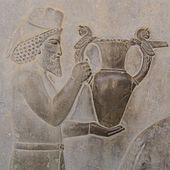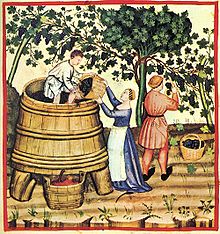Wine
 | |
| Type | Alcoholic beverage |
|---|---|
| Alcohol by volume | 6–21% |
| Ingredients | Varies; see Winemaking |
| Variants | |


Wine is an alcoholic drink typically made from fermented grapes. Yeast consumes the sugar in the grapes and converts it to ethanol, carbon dioxide and heat. Different varieties of grapes and strains of yeasts are major factors in different styles of wine. These differences result from the complex interactions between the biochemical development of the grape, the reactions involved in fermentation, the grape's growing environment (terroir), and the wine production process. Many countries enact legal appellations intended to define styles and qualities of wine. These typically restrict the geographical origin and permitted varieties of grapes, as well as other aspects of wine production. Wines not made from grapes involve fermentation of additional crops, including rice wine and other fruit wines such as plum, cherry, pomegranate, currant and elderberry.
Wine has been produced for thousands of years. The earliest evidence of wine is from ancient China (c. 7000 BC),[1][2][3][4][5] Georgia (6000 BC),[6][7] Persia (5000 BC), and Italy (4000 BC). New World wine has some connection to alcoholic beverages made by the indigenous peoples of the Americas, but is mainly connected to later Viking area of Vinland and Spanish traditions in New Spain.[8][9] Later, as Old World wine further developed viticulture techniques, Europe would encompass three of the largest wine-producing regions. Today, the five countries with the largest wine-producing regions are in Italy, Spain, France, the United States, and China.[10]
Wine has long played an important role in religion. Red wine was associated with blood by the ancient Egyptians[11] and was used by both the Greek cult of Dionysus and the Romans in their Bacchanalia; Judaism also incorporates it in the Kiddush, and Christianity in the Eucharist. Egyptian, Greek, Roman, and Israeli wine cultures are still connected to these ancient roots. Similarly the largest wine regions in Italy, Spain, and France have heritages in connection to sacramental wine, likewise, viticulture traditions in the Southwestern United States started within New Spain as Catholic friars and monks first produced wines in New Mexico and California.[12][13][14]
History[]

The earliest known traces of wine are from Georgia (c. 6000 BC),[6][7][16][17][18][19] Iran (Persia) (c. 5000 BC),[20][21] and Sicily (c. 4000 BC).[22] Wine reached the Balkans by 4500 BC and was consumed and celebrated in ancient Greece, Thrace and Rome. Throughout history, wine has been consumed for its intoxicating effects.[23][24][25]
The earliest archaeological and archaeobotanical evidence for grape wine and viniculture, dating to 6000–5800 BC was found on the territory of modern Georgia.[26][27] Both archaeological and genetic evidence suggest that the earliest production of wine elsewhere was relatively later, likely having taken place in the Southern Caucasus (which encompasses Armenia, Georgia and Azerbaijan), or the West Asian region between Eastern Turkey, and northern Iran.[28][29]
The earliest evidence of a grape and rice mixed based fermented drink was found in ancient China (c. 7000 BC),[1][2][3][4][5][4][5][30] earliest evidence of wine in Georgia from 6000 BC,[31][32][33] Iran from 5000 BC,[20] and Sicily from 4000 BC.[22]
The earliest known wineries from 4100 BC is the Areni-1 winery in Armenia.[15][34]

A 2003 report by archaeologists indicates a possibility that grapes were mixed with rice to produce mixed fermented drinks in ancient China in the early years of the seventh millennium BC. Pottery jars from the Neolithic site of Jiahu, Henan, contained traces of tartaric acid and other organic compounds commonly found in wine. However, other fruits indigenous to the region, such as hawthorn, cannot be ruled out.[35][36] If these drinks, which seem to be the precursors of rice wine, included grapes rather than other fruits, they would have been any of the several dozen indigenous wild species in China, rather than Vitis vinifera, which was introduced 6000 years later.[35]
The spread of wine culture westwards was most probably due to the Phoenicians who spread outward from a base of city-states along the Mediterranean coast of what are today Lebanon, Israel, Syria, and Palestine.[37] The wines of Byblos were exported to Egypt during the Old Kingdom and then throughout the Mediterranean. Evidence includes two Phoenician shipwrecks from 750 BC discovered by Robert Ballard, whose cargo of wine was still intact.[38] As the first great traders in wine (cherem), the Phoenicians seem to have protected it from oxidation with a layer of olive oil, followed by a seal of pinewood and resin, similar to retsina. Although the Nuragic culture in Sardinia already had a custom of consuming wine before the arrival of the Phoenicians.[39][40]
The earliest remains of Apadana Palace in Persepolis dating back to 515 BC include carvings depicting soldiers from Achaemenid Empire subject nations bringing gifts to the Achaemenid king, among them Armenians bringing their famous wine.
Literary references to wine are abundant in Homer (8th century BC, but possibly relating earlier compositions), Alkman (7th century BC), and others. In ancient Egypt, six of 36 wine amphoras were found in the tomb of King Tutankhamun bearing the name "Kha'y", a royal chief vintner. Five of these amphoras were designated as originating from the king's personal estate, with the sixth from the estate of the royal house of Aten.[41] Traces of wine have also been found in central Asian Xinjiang in modern-day China, dating from the second and first millennia BC.[42]

The first known mention of grape-based wines in India is from the late 4th-century BC writings of Chanakya, the chief minister of Emperor Chandragupta Maurya. In his writings, Chanakya condemns the use of alcohol while chronicling the emperor and his court's frequent indulgence of a style of wine known as madhu.[43]
The ancient Romans planted vineyards near garrison towns so wine could be produced locally rather than shipped over long distances. Some of these areas are now world-renowned for wine production.[44] The Romans discovered that burning sulfur candles inside empty wine vessels kept them fresh and free from a vinegar smell.[45] In medieval Europe, the Roman Catholic Church supported wine because the clergy required it for the Mass. Monks in France made wine for years, aging it in caves.[46] An old English recipe that survived in various forms until the 19th century calls for refining white wine from bastard—bad or tainted bastardo wine.[47]
Later, the descendants of the sacramental wine were refined for a more palatable taste. This gave rise to modern viticulture in French wine, Italian wine, Spanish wine, and these wine grape traditions were brought into New World wine. For example, Mission grapes were brought by Franciscan monks to New Mexico in 1628 beginning the New Mexico wine heritage, these grapes were also brought to California which started the California wine industry. Both of these regions eventually evolved into American wine's oldest and largest wine producers respectively.[48][49][50] Earlier Viking expeditions of Vinland recorded the first grape vines found in the New World,[51] and prior to the Spanish establishing their American wine grape traditions in California and New Mexico, both France and Britain had unsuccessfully attempted to establish grapevines in Florida and Virginia respectively.[52]
Etymology[]

The English word "wine" comes from the Proto-Germanic *winam, an early borrowing from the Latin vinum, Georgian ღვინო, "wine" or "(grape) vine", itself derived from the Proto-Indo-European stem *win-o- (cf. Armenian: գինի, gini; Ancient Greek: οἶνος oinos; Aeolic Greek: ϝοῖνος woinos; Hittite: wiyana; Lycian: oino).[53][54][55] The earliest attested terms referring to wine are the Mycenaean Greek